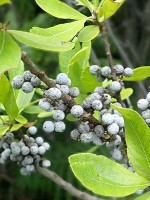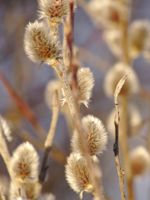Mon-Fri 9am - 5pm Mountain time
Pussy Willow vs Northern Bayberry
Myrica pensylvanica
Salix discolor
NOT AVAILABLE THIS SEASON - MIGHT RETURN
Northern Bayberry makes an excellent hedge or feature shrub. It will retain its leaves in warmer climates but drops them in colder areas. They produce blue-grey berries that have a wax coating on them that can be used to make candles or soaps.
In colder hardiness zones the leaves turn an attractive orange to red colour in the fall, making it a striking addition to your landscape.
Northern Bayberry is native to Nova Scotia and tolerates both drought and wet conditions. It is also a nitrogen fixer that tolerates poor soil conditions.
Pussy Willow is a large shrub or small tree that produces catkins that are soft, silky, and silvery before leaves appear in the spring. This native willow prefers moist to wet soil.
Pussy Willow makes a beautiful accent tree, and its bright branches can be used for floral arrangements or basket making.
All willow are important to native pollinators each spring as they have higher amounts of pollen and nectar early each growing season when other food sources are scarce.
Northern Bayberry Quick Facts
Pussy Willow Quick Facts
Toxicity: Warning: The wax from bayberry fruit is considered toxic and may be carcinogenic.

